Menu
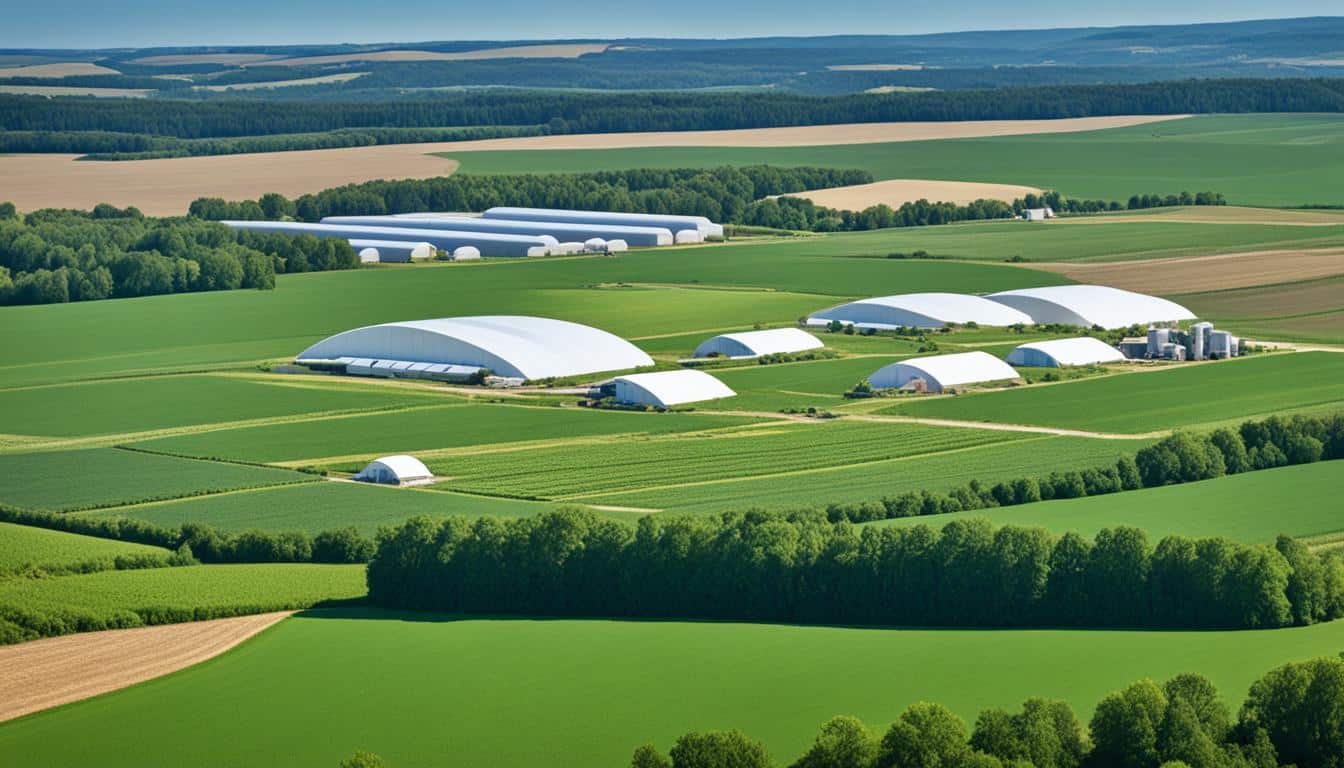
Did you know that the UK’s plan to help its farmers is going down, even after considering inflation? This big change is part of the many new things happening in British agriculture after Brexit. The move away from the European Union’s agricultural support plan, known as CAP, brings a mix of old and new ways for the farmers.
In the past, British farmers got big payments from the CAP. Now, they will deal with less money and a lot more rivalry. Although Brexit signals a break from the EU, some of the CAP’s ideas are staying in a different form. This change is hard because now UK farmers must also face off against EU farmers who are still getting help from the CAP.
The UK is selling less food to the EU since Brexit. This means big changes are needed in how trade and farming work together. In Scotland and Northern Ireland, farmers will still get help directly, which is not the same plan in England and Wales. Plus, in Northern Ireland, they have some special rules because of the Northern Ireland Protocol, which makes things even more different within the UK.
The talk about ‘new approaches’ in farming policy after Brexit mixes old and new ideas. England and Scotland especially show different ways to deal with things, like the environment and trade, which shows they have different main goals in policy.
For more about how British farming has changed since Brexit, click here.
After Brexit, the UK changed its agricultural plans. It moved away from the Common Agricultural Policy (CAP). This was a big step since CAP was a big part of farming in the UK for many years. The UK is now working on its own farming approach, looking at the good and bad of CAP. Let’s dive into what CAP did and how the UK is changing things now.
The Common Agricultural Policy (CAP) was criticised a lot. It cost a huge amount of money and mostly helped big farmers. Additionally, it encouraged farming methods that hurt the environment. Even when CAP tried to become more eco-friendly, its main problems continued.
The UK knew it needed to handle these problems when making new rules after Brexit. People wanted a more environmentally friendly and fair farming system. So, the UK needed to make big changes.
Now, the UK has to make farming policies that are both strong on their own and good for trade. This is tough as the UK is making its own way outside the EU. Different parts of the UK are making different choices. For example, England is paying farmers for the good things they do for the environment. This plan has more rules and needs more paperwork.
Scotland, on the other hand, is keeping direct payments to farmers. But, the money is given based on how well they look after nature. Each UK nation is going its own way, showing how the UK is changing after Brexit.
Overall, the UK will spend less on farming than before. This is because of lower money and prices going up. Different UK countries are also making different choices about food and farming. This makes moving from CAP to new ways quite the challenge.
As things move along, we see how hard it is to step away from CAP. There are many challenges, like dealing with old problems and following new rules. The UK is making its mark with new farming ways in the post-Brexit era.
Since Brexit, the UK’s devolved administrations have taken different paths in agricultural policy. This shows how hard it is to match agricultural rules across the UK after the EU. Each area now focuses on its unique goals and needs.
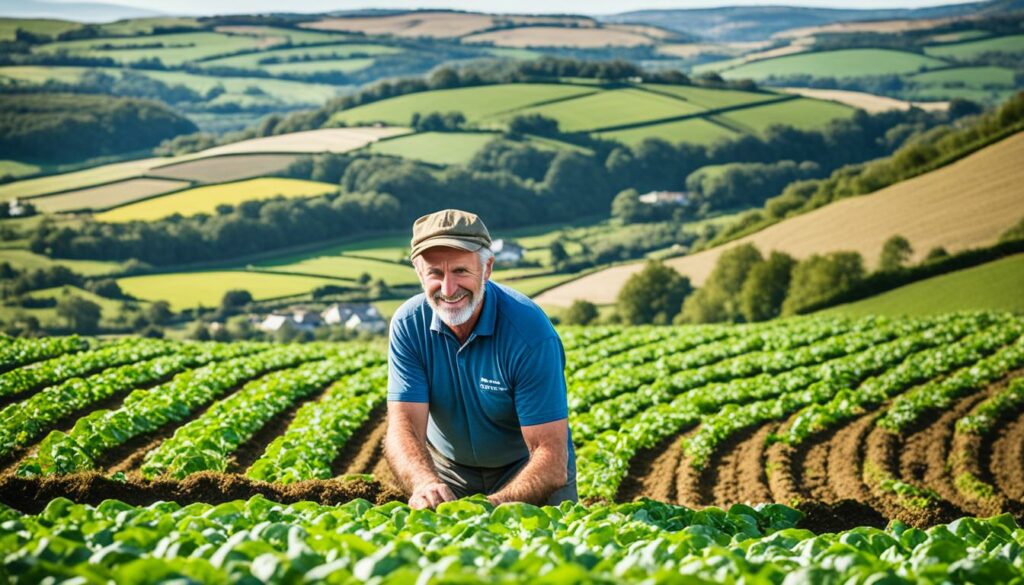
England leads with the Environmental Land Management Programme (ELMS). This scheme moves away from direct CAP payments towards rewarding farmers for public good delivery. Farmers get support for initiatives like cleaner air, healthier soil, and more wildlife, even though it involves more paperwork.
In Scotland, the spotlight is on making top-quality food in an environmentally friendly way and fighting climate change. Policies support farming that helps nature recover and prepare for climate changes. This sustainability approach stands out in Scotland’s agricultural decisions.
In Wales, a different strategy exists. Rather than a general farming support scheme, Wales uses focused efforts. They support farming that cares for the environment while producing food. In Wales, food production isn’t solely seen as a public benefit.
Northern Ireland, however, mainly focuses on producing food. It aims to maintain agricultural productivity. The Northern Ireland Protocol brings ‘dynamic alignment,’ tying it to future EU law changes. This could lead to more differences in rules across the UK.
| Region | Main Policy Focus |
|---|---|
| England | Environmental outcomes through ELMS |
| Scotland | High-quality food, sustainability, climate adaptation |
| Wales | Targeted support, environmental management |
| Northern Ireland | Food production, regulatory alignment with EU |
Brexit has changed how UK farming gets its subsidies. The UK has moved its focus. Now, UK farmers face big changes in how they get financial help.
Before Brexit, farms in the UK got about €4 billion a year from CAP. But the amount of food they sell to the EU has dropped a lot. This shows why changes to post-Brexit farming support are needed.
England’s moved from giving direct cash to supporting what’s good for the public. This is through the ELMS. But it offers less money and comes with a lot of rules. This makes things more complicated and expensive for farmers.
In Scotland, the main focus is on making quality food, looking after nature, and fighting climate change. They’re working to mix the old CAP support with new environmental goals. This is how they hope to do better overall.
In Northern Ireland, the main aim is still producing food. They don’t put as much focus on protecting the environment. They have to keep up with some EU laws, which makes their situation more complex.
Let’s look at how each part of the UK deals with farming money:
| Region | Key Policy Focus | Funding Adaptation |
|---|---|---|
| England | Environmental sustainability | ELMS: Smaller aggregates, higher transaction costs |
| Scotland | Food production, sustainability, climate change | Integrated approach to CAP replacement subsidies |
| Northern Ireland | Food production | Lower emphasis on environment, dynamic alignment with EU |
Unlike England and Wales, Scotland and Northern Ireland still give direct support to farmers. This shows a difference in how farming is supported in the UK.
With these changes, UK farmers face more expenses. This is due to getting less help from the EU. They must follow new rules but still compete with farmers in the EU.
After Brexit, the UK is trying to find a balance. They want to protect local farming and the environment. But they also aim to push for new ideas and ways of farming. This comes at a time when the total money for farming support might go down.
Since the UK left the EU, it’s vital to form new trade deals. The UK’s agriculture was worth about $34.2 billion (£26.7 billion) in 2020. Now, there are new challenges and chances for trade after Brexit. The effects on the UK’s agriculture exports, worth $30.5 billion in 2020, have been big.
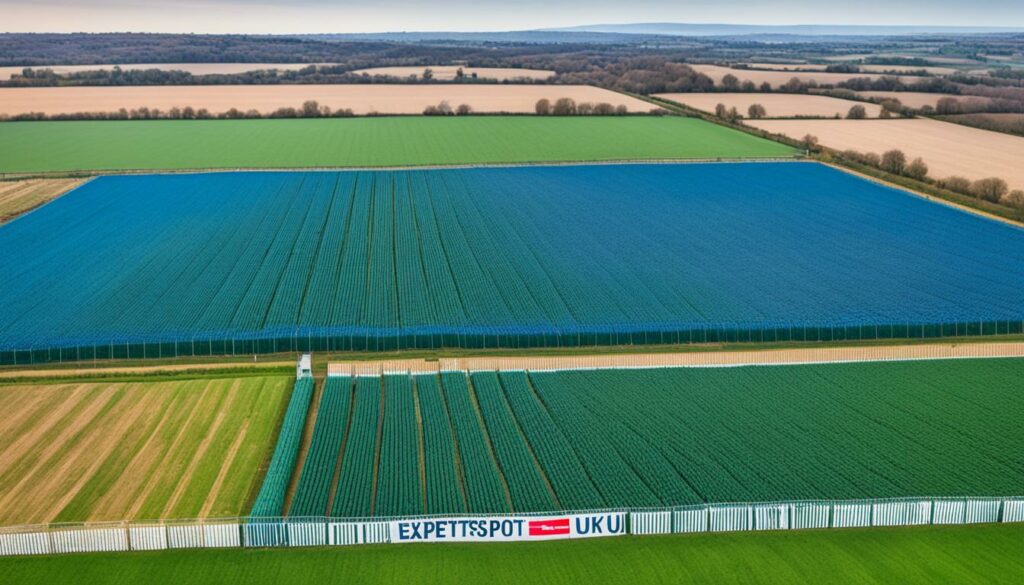
The UK has quickly started new trade relationships after Brexit. It signed deals with Australia and New Zealand. These deals could bring competition from bigger farms, which might harm local ones. On the bright side, trade after Brexit offers a way to strengthen ties with the U.S. In 2020, the U.S. sold $2.7 billion of farm goods to the UK. The UK sold $1.1 billion to the U.S. This deal could help both countries.
Export challenges and chances have come up after Brexit. The UK makes a lot from its exports, but it buys more than it sells. Yet, there’s hope to sell more to new places. The U.S. selling more to the UK since 1990 shows a chance for growth. Forest products and fresh veggies have seen big growth. This shows the markets could grow further.
But, there are tough bits too. The UK is facing the effects of less trade with the EU, which was the main market before. Now, high-value goods are coming in more. UK farmers need to find new ways to stay competitive. Remember, farming’s value to the UK is under 1 percent of the whole. So, the focus should be on smart and sustainable trading.
Britain’s farming is focusing more on sustainability after Brexit. New policies are being made without the old CAP system. The CAP was criticized for giving more to EU farmers and hurting UK ones.
Defra has introduced ELMS to encourage environmental care in farming. This move shows the UK’s shift towards sustainable farming. ELMS is part of a plan to cut carbon emissions and stop direct payments in England and Wales.
In Scotland, there’s a push for great food that’s also green. They’re following policies that help farming and protect the environment. Northern Ireland has its own path due to the Protocol, leading to different challenges.
Support for farmers will decrease post-Brexit, leading to financial challenges. Finding new ways to fund farming without CAP is slow. The ending of cross compliance by 2023 is a big change.
Through SFI and CS, there’s new funding for farmers. These schemes focus on making farming greener and more sustainable. They aim to lower carbon emissions and improve nature.
| Region | Main Focus | Key Initiatives |
|---|---|---|
| England | Environmental Sustainability | Environmental Land Management Programme (ELMS) |
| Scotland | High-Quality Food, Climate Change Mitigation | Green Farming Initiatives |
| Wales | Basic Support | Resistance to Defining Food Production as Public Good |
| Northern Ireland | Food Production | Dynamic Alignment with EU Laws |
After Brexit, the support for farmers in the UK has changed a lot. The UK government is now using new ways to help farmers. They’re no longer using the old Common Agricultural Policy but focusing on the Sustainable Farming Incentive and Countryside Stewardship. These new plans aim to help farmers financially and push for more sustainable farming practices.
The UK has set aside £2.4 billion each year for Environmental Land Management schemes (ELMs). This big budget shows the government’s serious about eco-friendly farming. For over 280 actions, farmers can get money for helping the environment. The payments can be from £10.38 to £1,920 per hectare, based on what they do.
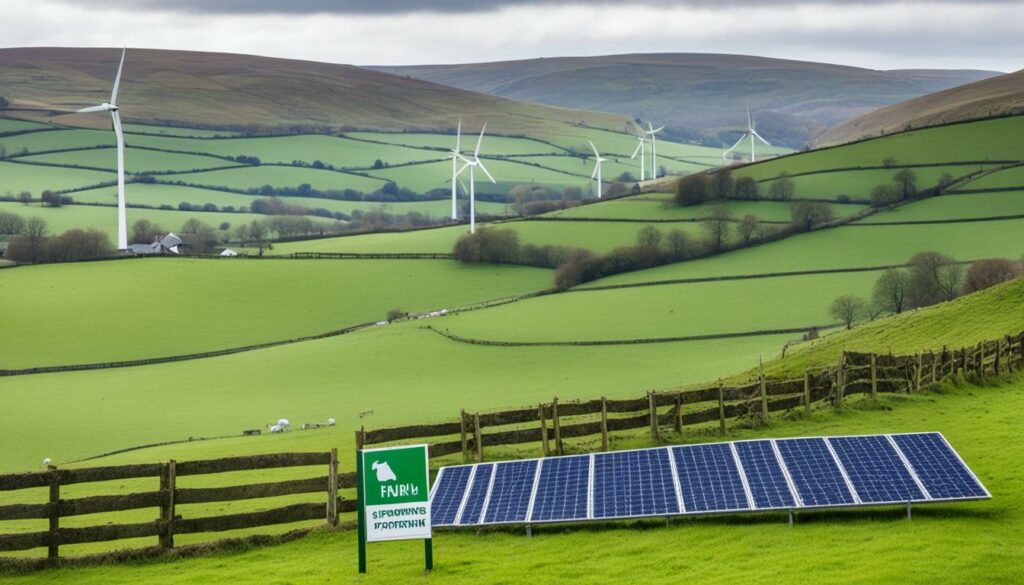
In 2023, the UK government gave out over £168 million in grants for new ideas, farm animal welfare, and to protect the environment. They also said they’ll give £45 million more for robots and automatic farm equipment. This shows they want to see more high-tech solutions in farming, like robots that weed.
Applying for these subsidies is quick, taking only 45 minutes. In 2023, about 8,000 farmers applied for the Sustainable Farming Incentive. This shows lots of farmers are interested in these new ways of funding. The Country Land and Business Association, which represents 28,000 farmers, also supports these new approaches.
It’s expected that more farmers will join in 2024, thanks to better payment rates. But some people say these changes help big farms more than small ones or those in tough areas. Yet, with over 50 new actions eligible for funding, these programmes are meant to suit many farming types. For example, creating special areas for birds can earn £765 per hectare. Caring for river and floodplain areas can get £1,242 per hectare. This way of giving money doesn’t just help financially, it’s a part of the UK’s plan to improve the natural environment by 2030.
The new way the UK supports farmers after Brexit tries to balance finance with saving the environment. In this changing world, supporting both sustainability and new ideas is key for the future of farming in the UK.
Brexit has significantly changed life in UK rural areas. It’s affecting how they get funds, sell their products, and what is focused on in policies. With the EU gone, rural communities are looking at new ways to thrive and survive.
Brexit’s effect on rural areas is deep and wide-ranging. They used to get a big helping hand from EU funds, which kept their economy strong and farming productive. Now, they face less money for rural support and higher prices.
This change hits hard, especially as the UK cuts off direct payments from the CAP. This is happening in England, leaving farmers with fewer resources to keep going. So, the economy of rural areas is feeling the strain.
Complicating things further is how different parts of the UK are handling their support. Wales, for example, is not quick to help all farmers equally. Meanwhile, Scotland is aiming for high standards in food, environmental care, and fighting climate change. This means rural communities need to keep up with a mix of new rules and ideas.
Since Brexit, rural places have to adjust to new farm policies to stay strong. The way money is given out has changed, leaving behind the old EU system. In Wales, policies could still move close to EU rules due to the Protocol, while England is moving further away.
Rural areas need to think ahead about how to fit into these new policies. They should also look at being able to sell in different ways and stay in business for the long run. This means changing how they farm to meet green goals without losing money. It’s a challenging shift that has to be done carefully.
Market changes and new tech are central post-Brexit. They help face challenges and seize opportunities. The UK is all in, promoting new tech in farming to boost efficiency and be green.
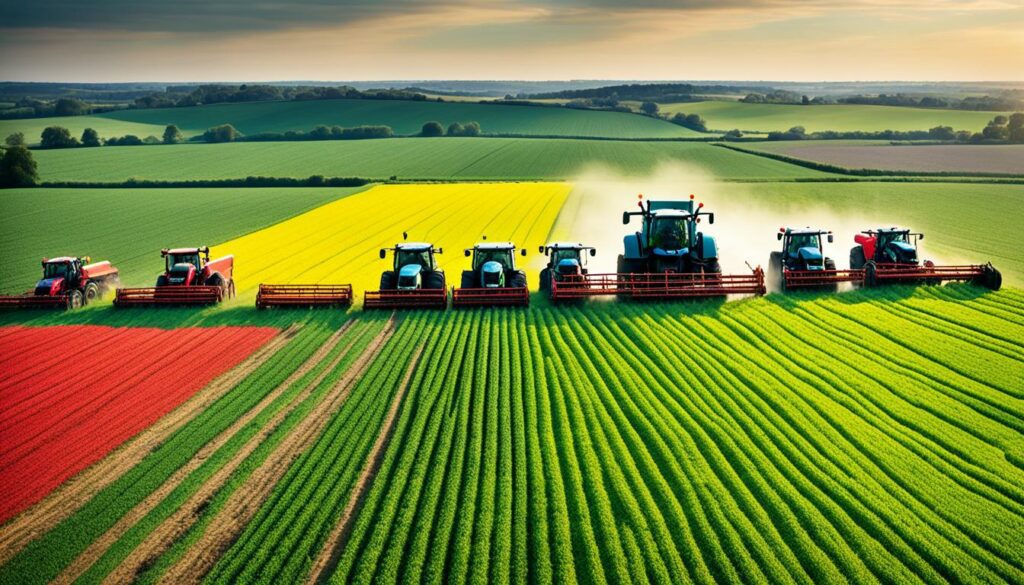
Farmers need to adapt to new rules and markets. Robotic weeding is a big help, cutting down on chemical use and helping the environment. These new tools aim to make farming more efficient and sustainable.
The tech shift fits with the Common Agricultural Policy’s goals. It includes using arable land for nature and promoting eco-schemes. These eco-efforts get a good share of direct payment budgets.
Post-Brexit UK farming is about more than just change. It means leading in green farming methods. The UK wants to be at the forefront of sustainable agriculture.
| Policy Elements | Details |
|---|---|
| Eco-schemes Budget Allocation | At least 25% allocated to promote sustainable farming |
| Biodiversity and Non-Productive Land | Minimum 3% dedicated with potential support up to 7% |
| Climate and Environment Support | 35% of funds directed towards climate-related actions |
| CAP Budget for Climate-Relevant Actions | 40% allocated to climate and biodiversity support |
| Young Farmers’ Support | 3% of direct payments budget |
After Brexit, the UK’s farming sector will use new tech for better and eco-friendly market changes. It matches new tech with farming needs. This approach helps boost farming, meeting environmental goals.
This strategy is key for strong and smart farming after Brexit.
The UK has left the EU, yet European agricultural policies deeply impact Britain. This influence is felt in issues around public goods and making farming more eco-friendly.
UK farmers don’t get as much help as they did under the EU’s CAP. This means they find it tough to compete with farmers from the EU who still receive big payments.
One big difference is how the payments for public goods work. In the UK, the ELMS focus on good for the public, like cleaner air, but have more rules and are not as big as what the EU gives. Also, the money for helping farmers in the UK is expected to go down, while the EU’s CAP is putting more focus on funding for many different functions.
In Scotland, farm policy aims to make top-quality food in a way that’s good for the environment and fights climate change, just like the EU wants. But it also adjusts for what Scotland really needs. Wales and Northern Ireland have their own focus. Wales doesn’t like the idea of giving the same support to all farmers. Northern Ireland puts strong emphasis on keeping up food production, a choice linked to their trading arrangements with the EU.
The CAP has changed a lot over time, with big updates in 2003, 2013, and plans for 2023-2027. These changes show a big shift from helping with prices to giving direct payments. They also include support for the environment and special help for young farmers. All these changes are key in the way farming is managed.
Learning from the CAP updates shows why it’s crucial to match policies with bigger economic and eco goals. For example, the CAP reforms starting from 2000 tied farming’s success to taking care of the environment. The UK can learn from this, balancing business success with looking after nature. This idea is important in both the EU’s and the UK’s future plans for farming.
| Aspect | EU | UK |
|---|---|---|
| Primary Support Mechanism | CAP | ELMS |
| Budget Trend | Stable/Increased | Declining |
| Focus Areas | Multifunctionality, Environmental Sustainability | Public Goods, Environmental Impact |
| Payment Conditions | Compliance with Regulations | More Conditional Payments |
Looking at comparative agricultural policy, the flexibility that EU Member States have could guide the UK. Such flexibility can meet major goals while fitting the needs of different areas.
Both UK and EU farm policies show an always-evolving scene. We learn from each other, making changes that fit our future. I’m keen to see how these efforts will shape our farming in years to come.
Since Brexit, Northern Ireland has a special place, thanks to the Protocol. This rule means it must follow EU laws closely. It’s because of Article 13(3) of the Protocol. This keeps Northern Ireland connected to the EU’s changes. This mainly affects how it handles agricultural policies compared to the rest of the UK.

The EU’s Common Agricultural Policy (CAP) was important when the UK was a member. It used a big part of the EU budget but wasn wasn’t perfect. The UK made changes to reduce costs and support better farming practices. Now, after Brexit, Northern Ireland’s focus remains on farming. This is different from how England supports farm improvement programs over just farming.
After Brexit, Northern Ireland sticks closely to new EU laws thanks to the Protocol. By July 2023, 308 EU laws became part of Northern Ireland’s rules. This ties Northern Ireland closely to the EU, which differs from how the rest of the UK works. England and Wales, for example, move away from direct farming payments. This shows both change and some similarity to the pre-Brexit rules.
In the UK, the money for farming support is likely to go down. Yet, Northern Ireland staying close to the EU might give some support. Still, this situation could lead to different farm rules within the UK. It presents challenges and chances for Northern Ireland’s farms.
In conclusion, the relations Northern Ireland has with EU laws and its unique farming policies are crucial. They show us how Northern Ireland is moving forward after Brexit. It’s important to understand these changes in regulations for the region’s future.
The UK leaving the EU has led to big changes in food production focus. There’s now a strong push to grow more food at home. The aim is for the UK to make at least 60% of the food it eats.
After Brexit, there’s a big push to strengthen local food chains. This is vital for making sure we have enough food and it’s not too expensive. For example, extra food checks for exports to Europe cost £60 million more in 2021.
Regions like Wales have faced tough times, with many farms not making money. Subsidies are proving crucial for 42% of UK farms to stay afloat. As old support systems change, new food security plans are key.
Global events also shape our food plans. If China adds big taxes on New Zealand lamb, more could come to the UK. This shows how the world’s actions affect our food production.
Income for farmers in tough areas rose by 32% to almost £30,000. This is a good sign post-Brexit. But, the weaker Pound after the Brexit vote has made imported food cost more.
Brexit has made us rethink how we farm. The UK aims to be more self-sufficient while still trading globally. We need strong plans for food security that work with trade.
After Brexit, the UK has changed how it supports farming. It moved away from the EU’s Common Agricultural Policy (CAP). Now, the UK is creating its own rules. These encourage farming that’s kinder to the environment and tackle climate change.

In England, they’re shifting to the Environmental Land Management Programme (ELMS). This means farmers get paid for good environmental work. Yet, it’s more complex than before and can cost more to set up. Scotland focuses on producing high-quality food while also caring for the environment and restoring nature.
Northern Ireland is all about producing food. It gives less attention to green issues compared to other places in the UK. But it will keep up with new green rules set by the EU, as required by the Protocol.
The UK and the EU are keen on rewarding farmers for helping the planet and fighting climate change. They want to lessen the carbon footprint of farming. This can mean creating habitats, using new tech, and cutting down emissions from farming.
| Region | Focus Areas | Challenges |
|---|---|---|
| England | Environmental sustainability, ELMS | Higher transaction costs, complex conditions |
| Scotland | Food production, sustainability, nature restoration | Balancing diversification and sustainability |
| Wales | Food production, minimising environmental damage | Defining public goods |
| Northern Ireland | Primarily food production | Dynamic alignment with EU laws |
After Brexit, the UK is making its own rules for agriculture. This lets the UK explore new places to sell and make new trade friends. But, fitting in with world rules and keeping trade easy, especially with the EU, is hard.
While in the EU, the UK’s farmers had to compete with those getting more money from the CAP. But now, Brexit has made it harder to sell food to the EU. This means the UK must find new ways to do business fast.
Each part of the UK has its rules and ways of farming. For example, England is stopping direct payments to farmers, but Scotland and Northern Ireland are keeping some help. This shows how UK farming is changing because of Brexit.
See how cutting payments will affect UK farmers by 2024:
| Farmer Group | Initial Cuts (2021) | Cuts by 2024 |
|---|---|---|
| Smallest Group | 5% | 50% |
| Largest Group | 25% | 70% |
The UK also plans to put about one billion pounds into eco-friendly farming. This means more cash for plans like helping nature bounce back or farming that helps the earth. These plans will get more money than they did under the CAP.
In England, farm rules are focusing more on helping the environment. But there is still a debate between protecting farms and letting them do their own thing. The big story about how the UK is doing its own farming rules, away from the EU, is still changing a lot. This shows how UK farming is moving on after Brexit.
The Brexit transition has brought a big change for the UK in farming. Leaving the EU’s Common Agricultural Policy (CAP) affected the farming sector a lot. The money from the EU for farming went down, which hits UK farmers hard. Now, they’re up against EU farmers who still get good payments from the CAP.
Changes in laws also affected food exports, which dropped a lot after Brexit. Scotland and Northern Ireland are keeping some direct payments for farmers. But England and Wales are stopping these payments. Instead, they’re trying out new ways with the countryside stewardship scheme.
UK farming now faces both old and new challenges. It needs to compete with EU farmers but also set up new and good farming plans. Brexit hasn’t clear its effects on farming yet. But it does offer chances for new ideas, like working with countries such as New Zealand.
Gone are the days when UK farmers meant the world to the EU. Now they walk their own path, facing both hurdles and chances. The key is to mix the best from the UK’s farming past with fresh approaches. In this post-Brexit era, UK farming stands at a critical crossroads.
Post-Brexit, the UK has moved from the EU’s agricultural policy. It now has new subsidy plans to boost the environment, encourage innovation, and change trading ties. These new rules show the UK’s different agricultural needs compared to the EU.
The Environmental Land Management Programme (ELM) in England changes how farmers are paid. Instead of directly helping with production costs, it pays for good things for the environment. This includes making nature better, cleaning water, and lowering carbon in the air.
Brexit has big effects on places where farming is a big deal. It changes money support, how farms can sell their goods, and focuses more on helping the planet. So, places that relied on EU help need to find new ways to keep their local economy strong.
With the EU’s way of helping no longer used, the UK has made its own plans to support farming. These new ways, like the Sustainable Farming Incentive, are all about better farming for the planet. Now, the support is not just about money but about looking after the environment too.
Getting into new trade deals, like with Australia and New Zealand, can be good and tough. On one hand, it opens up selling more food to new countries. But, there’s worry it could make selling at home harder because of different rules and too much competition.
After Brexit, farming policies in the UK are much more about looking after the planet. There are new incentives to farm in ways that cut pollution, save species, and make the Earth healthier. The goal is to farm better for the future of our planet.
Because of devolution, the UK’s nations have their own farming rules. For example, England’s ELM focuses on helping nature, while Scotland looks at farming and the climate together. Wales has its approach, and Northern Ireland is more like the EU because of a special agreement.
The UK is backing new farm tech to make farming more efficient and greener. Things like robots for weeding and precise farming tools are being supported. This will help farms to use less and do more for the Earth.
The Northern Ireland Protocol means Northern Ireland keeps up with EU farm rules. This might make their way of farming a bit different from the rest of the UK. It affects how they do trade and what their farming laws are like.
After Brexit, the UK wants more of its own food on the table. The goal is to have at least 60% of our food grown here. This helps our food supply be stronger, given the new trade deals and ways of supporting farming.
Post-Brexit, the UK’s farming ways are more about fighting climate change. There are new rewards for creating wildlife-friendly spaces, using new tech, and cutting down on pollution. The aim is to farm in a way that helps, not harms, our planet.
After Brexit, the UK and EU have gone their separate ways on farming policies. The UK is putting more focus on the environment and coming up with new ideas. Meanwhile, the EU is changing its common farming rules. This lets the UK do farming its own way but also brings new challenges in trading and rules.
From the EU, the UK can learn a lot about making farming greener and more sustainable. Even though the UK and EU are different, ideas about better policies and talking to people who farm apply. These lessons help the UK shape its farming future.
After Brexit, the UK can make its own agri rules, which can affect trading with the EU. Making sure the UK rules match with the company can be hard but crucial. The aim is to trade well, keep the market open, and still follow global rules.